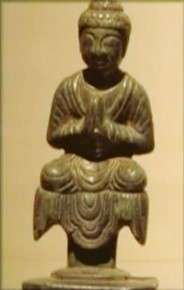Early Lý dynasty
| Early Lý Dynasty | ||||||||||
| House of Early Lý 前李朝 | ||||||||||
| ||||||||||
 Map of Vạn Xuân kingdom during Early Lý dynasty | ||||||||||
| Capital | Long Biên | |||||||||
| Government | Monarchy | |||||||||
| Kings | ||||||||||
| • | 544–548 | Lý Nam Đế (first) | ||||||||
| • | 571–602 | Hậu Lý Nam Đế (last) | ||||||||
| History | ||||||||||
| • | Lý Bí proclaimed himself king | 544 | ||||||||
| • | Surrender of Hậu Lý Nam Đế | 602 | ||||||||
| ||||||||||
The Early or Anterior Lý Dynasty (Vietnamese: nhà Tiền Lý) was a dynasty which ruled Vietnam from AD 544 to 602. Its founder Lý Bí assumed the title of "Southern Emperor" (Lý Nam Đế). The realm of the Early Lý was known as Vạn Xuân ("Myriad Springs") and their capital was at Long Biên within modern Hanoi, which they renamed Thăng Long.
Political resistance
The sixth century was an important stage in the Vietnamese political evolution toward independence. During this period, the Vietnamese aristocracy became increasingly independent of Chinese authority, while retaining Chinese political and cultural forms. At the same time, indigenous leaders arose who claimed power based on Vietnamese traditions of kingship. A series of failed revolts in the late sixth and early seventh centuries increased the Vietnamese national consciousness. Lý Bí (Lý Nam Đế), the leader of a successful revolt in 543 against the Liang dynasty, was himself descended from a Chinese family that had fled to the Red River Delta during a period of dynastic turbulence in the first century A.D.[1][2][3][4][5][6][7][8][9][10] Lý Bí declared himself emperor of Nam Việt in the tradition of Triệu Đà and organized an imperial court at Long Biên.[11] Lý Bí was killed in 547, but his followers kept the revolt alive for another fifty years, establishing what is sometimes referred to in Vietnamese history as the Earlier Lý Dynasty.

While the Lý family retreated to the mountains and attempted to rule in the style of their Chinese overlords, a rebel leader who based his rule on an indigenous form of kingship arose in the Red River Delta. Triệu Quang Phục made his headquarters on an island in a vast swamp.[12] From this refuge, he could strike without warning, seizing supplies from the Liang army and then slipping back into the labyrinthine channels of the swamp. Despite the initial success of such guerrilla tactics, by which he gained control over the Red River Delta, Triệu Quang Phục was defeated by 570. According to a much later Vietnamese revolutionary, General Võ Nguyên Giáp, Vietnamese concepts of protracted warfare were born in the surprise offensives, night attacks, and hit-and-run tactics employed by Triệu Quang Phục.
Anterior Lý Dynasty
Regal Titles
- Lý Nam Đế I (r. 542–548) Lý Nam Đế's pre-throne name was Lý Bí, also known as Lý Bôn.[13]
- Lý Thiên Bảo (r. 548–555, co-reigned with Triệu Quang Phục)
- Triệu Việt Vương (r. 548–571, 555–571 as sole ruler)
- Lý Nam Đế II (r. 571–602)
Notes
- ↑ Taylor (1983), p. 135
- ↑ Walker (2012), p. 134 East Asia: A New History, p. 134, at Google Books
- ↑ Catino (2010), p. 142 The Aggressors: Ho Chi Minh, North Vietnam, and the Communist Bloc, p. 142, at Google Books
- ↑ Kohn (2006), p. 308 Dictionary of Wars, p. 320, at Google Books
- ↑ Coedès (1966), p. 45 The Making of South East Asia, p. 45, at Google Books
- ↑ Coedès (1966), p. 46 The Making of South East Asia, p. 46, at Google Books
- ↑ Lockhart (2010), p. 221 The A to Z of Vietnam, p. 221, at Google Books
- ↑ Lockhart (2010), p. 221 The A to Z of Vietnam, p. 221, at Google Books
- ↑ West (2009), p. 870 Encyclopedia of the Peoples of Asia and Oceania, p. 870, at Google Books
- ↑ Taylor (1991), p. 155 The Birth of Vietnam, p. 155, at Google Books
- ↑ Tucker, p. 8
- ↑ Tucker, p. 9
- ↑ Spencer Tucker Encyclopedia of the Vietnam War: a political, social, and military History Volume 1 Oxford University Press. Page 393 - 1998 " Founder of the early Lý dynasty, Ly Bôn was born into a wealthy family in Long Hưng District, Thái Bình Province. Bon was an official for the Chinese colonial administration ruling Vietnam. A talented individual, he left government service to prepare for an uprising that forced the Chinese governor out of Vietnam. Bon took Thăng Long (Hà Nội) and built a new independent state named Vạn Xuân (Ten Thousand Years of Spring)."
References
- Taylor, Keith Weller. (1983). The Birth of Vietnam (illustrated, reprint ed.). University of California Press. ISBN 0520074173. Retrieved 7 August 2013.
- Tucker, Spencer C. Vietnam. University Press of Kentucky, Feb 25, 1999 - 256 pages
| Preceded by Second Chinese domination |
Dynasty of Vietnam 544–602 |
Succeeded by Third Chinese domination |
